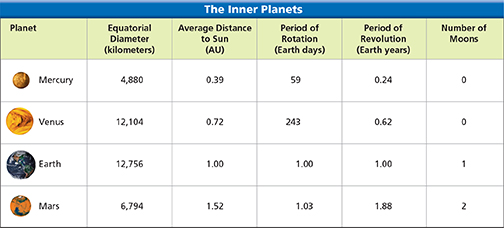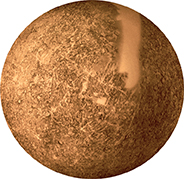Because they are closer to the sun, the terrestrial planets are much warmer on average than the outer planets. Unlike most of the outer planets, the inner planets have few (if any) moons. There are no rings around any of the terrestrial planets. Figure 12 summarizes the main characteristics of the inner planets.
Mercury
 Mercury is the smallest of the terrestrial planets, and the closest planet to the sun. Mercury, shown in Figure 13, is a dense planet with a very large iron core. Mercury is geologically quiet. There is little mantle convection within the planet, and little erosion on its surface.
Mercury is the smallest of the terrestrial planets, and the closest planet to the sun. Mercury, shown in Figure 13, is a dense planet with a very large iron core. Mercury is geologically quiet. There is little mantle convection within the planet, and little erosion on its surface.
Like its namesake, the swift messenger of the gods, Mercury is the fastest-moving planet. It takes only 88 Earth days for Mercury to complete one revolution. This is the shortest period of revolution of any planet.
Temperature and Atmosphere
Mercury's surface temperature ranges between two extremes. The time between sunrise and sunset equals the time it takes for Mercury to revolve around the sun, about 88 days. During this time, the heat from the sun causes the surface to become intensely hot. The temperatures at the equator reach about 430ºC, hot enough to melt lead. At night, the temperature becomes extremely cold, as low as − 170ºC.
Mercury has virtually no atmosphere. Its high daytime temperatures cause gas particles to move very fast. Because Mercury is so small, its gravity is weak, making it easy for such fast-moving gas particles to escape into space.

Why does Mercury lack a substantial atmosphere?
Figure 12 The inner planets are all small, dense, and rocky. Using Tables Which of the four inner planets is most similar in size to Earth?
 d
dFigure 13 Mercury's surface is heavily cratered from meteoroid collisions. This false-color image was made by combining a series of smaller images taken by the Mariner 10 space probe. Orange areas for which no images are available are blank.
Comparing and Contrasting How does Mercury's surface compare with the surface of Earth's moon?





